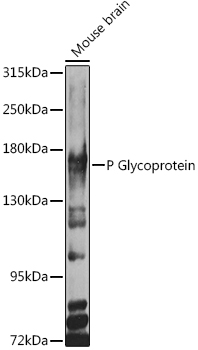![Whole cell extract (30 microg) was separated by 5% SDS-PAGE, and the membrane was blotted with P Glycoprotein antibody [C219] (GTX23364) diluted at 1:500. The HRP-conjugated anti-mouse IgG antibody (GTX213111-01) was used to detect the primary antibody, and the signal was developed with Trident ECL plus-Enhanced. Whole cell extract (30 microg) was separated by 5% SDS-PAGE, and the membrane was blotted with P Glycoprotein antibody [C219] (GTX23364) diluted at 1:500. The HRP-conjugated anti-mouse IgG antibody (GTX213111-01) was used to detect the primary antibody, and the signal was developed with Trident ECL plus-Enhanced.](https://www.genetex.com/upload/website/prouct_img/normal/GTX23364/GTX23364_821900375_20190412_WB_w_23060620_955.webp)
Whole cell extract (30 microg) was separated by 5% SDS-PAGE, and the membrane was blotted with P Glycoprotein antibody [C219] (GTX23364) diluted at 1:500. The HRP-conjugated anti-mouse IgG antibody (GTX213111-01) was used to detect the primary antibody, and the signal was developed with Trident ECL plus-Enhanced.
P Glycoprotein antibody [C219]
GTX23364
ApplicationsFlow Cytometry, ImmunoFluorescence, ImmunoPrecipitation, Western Blot, ELISA, ImmunoCytoChemistry, ImmunoHistoChemistry, ImmunoHistoChemistry Frozen, ImmunoHistoChemistry Paraffin
Product group Antibodies
ReactivityBovine, Canine, Fish, Human, Mouse, Rat, Zebra Fish
TargetABCB1
Overview
- SupplierGeneTex
- Product NameP Glycoprotein antibody [C219]
- Delivery Days Customer9
- Application Supplier NoteWB: 1:50-1:500. IHC-P: ≥1:25. FACS: . *Optimal dilutions/concentrations should be determined by the researcher.Not tested in other applications.
- ApplicationsFlow Cytometry, ImmunoFluorescence, ImmunoPrecipitation, Western Blot, ELISA, ImmunoCytoChemistry, ImmunoHistoChemistry, ImmunoHistoChemistry Frozen, ImmunoHistoChemistry Paraffin
- CertificationResearch Use Only
- ClonalityMonoclonal
- Clone IDC219
- ConjugateUnconjugated
- Gene ID5243
- Target nameABCB1
- Target descriptionATP binding cassette subfamily B member 1
- Target synonymsABC20, CD243, CLCS, ENPAT, GP170, MDR1, P-GP, PGY1, p-170, ATP-dependent translocase ABCB1, ATP-binding cassette, sub-family B (MDR/TAP), member 1, P-glycoprotein 1, colchicin sensitivity, doxorubicin resistance, multidrug resistance protein 1, phospholipid transporter ABCB1
- HostMouse
- IsotypeIgG1
- Protein IDP08183
- Protein NameATP-dependent translocase ABCB1
- Scientific DescriptionThe membrane-associated protein encoded by this gene is a member of the superfamily of ATP-binding cassette (ABC) transporters. ABC proteins transport various molecules across extra- and intra-cellular membranes. ABC genes are divided into seven distinct subfamilies (ABC1, MDR/TAP, MRP, ALD, OABP, GCN20, White). This protein is a member of the MDR/TAP subfamily. Members of the MDR/TAP subfamily are involved in multidrug resistance. The protein encoded by this gene is an ATP-dependent drug efflux pump for xenobiotic compounds with broad substrate specificity. It is responsible for decreased drug accumulation in multidrug-resistant cells and often mediates the development of resistance to anticancer drugs. This protein also functions as a transporter in the blood-brain barrier. Mutations in this gene are associated with colchicine resistance and Inflammatory bowel disease 13. Alternative splicing and the use of alternative promoters results in multiple transcript variants. [provided by RefSeq, Feb 2017]
- ReactivityBovine, Canine, Fish, Human, Mouse, Rat, Zebra Fish
- Storage Instruction-20°C or -80°C,2°C to 8°C
- UNSPSC12352203
References
- Voirin AC, Chatard M, Briançon-Marjollet A, et al. Loss of Blood-Brain Barrier Integrity in an In Vitro Model Subjected to Intermittent Hypoxia: Is Reversion Possible with a HIF-1α Pathway Inhibitor? Int J Mol Sci. 2023,24(5). doi: 10.3390/ijms24055062Read this paper
- Olivera GC, Ross EC, Peuckert C, et al. Blood-brain barrier-restricted translocation of Toxoplasma gondii from cortical capillaries. Elife. 2021,10. doi: 10.7554/eLife.69182Read this paper
- Wang SA, Young MJ, Wang YC, et al. USP24 promotes drug resistance during cancer therapy. Cell Death Differ. 2021,28(9):2690-2707. doi: 10.1038/s41418-021-00778-zRead this paper
- Levi M, Muscatello LV, Brunetti B, et al. High Intrinsic Expression of P-glycoprotein and Breast Cancer Resistance Protein in Canine Mammary Carcinomas Regardless of Immunophenotype and Outcome. Animals (Basel). 2021,11(3). doi: 10.3390/ani11030658Read this paper
- Zou W, Xia M, Jiang K, et al. Photo-Oxidative Degradation Mitigated the Developmental Toxicity of Polyamide Microplastics to Zebrafish Larvae by Modulating Macrophage-Triggered Proinflammatory Responses and Apoptosis. Environ Sci Technol. 2020,54(21):13888-13898. doi: 10.1021/acs.est.0c05399Read this paper
- Deligne C, Hachani J, Duban-Deweer S, et al. Development of a human in vitro blood-brain tumor barrier model of diffuse intrinsic pontine glioma to better understand the chemoresistance. Fluids Barriers CNS. 2020,17(1):37. doi: 10.1186/s12987-020-00198-0Read this paper
- Kawase A, Nakasaka M, Bando H, et al. Changes in Radixin Expression and Interaction with Efflux Transporters in the Liver of Adjuvant-Induced Arthritic Rats. Inflammation. 2020,43(1):85-94. doi: 10.1007/s10753-019-01097-9Read this paper
- Yamaguchi T, Shimizu K, Kokubu Y, et al. Effect of heat stress on blood-brain barrier integrity in iPS cell-derived microvascular endothelial cell models. PLoS One. 2019,14(9):e0222113. doi: 10.1371/journal.pone.0222113Read this paper
- Yaguchi Y, Tachikawa M, Zhang Z, et al. Organic Anion-Transporting Polypeptide 1a4 (Oatp1a4/Slco1a4) at the Blood-Arachnoid Barrier is the Major Pathway of Sulforhodamine-101 Clearance from Cerebrospinal Fluid of Rats. Mol Pharm. 2019,16(5):2021-2027. doi: 10.1021/acs.molpharmaceut.9b00005Read this paper
- Yan A, Joachims ML, Thompson LF, et al. CD73 Promotes Glioblastoma Pathogenesis and Enhances Its Chemoresistance via A(2B) Adenosine Receptor Signaling. J Neurosci. 2019,39(22):4387-4402. doi: 10.1523/JNEUROSCI.1118-18.2019Read this paper




